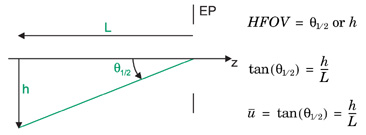Optipedia • SPIE Press books opened for your reference.
Field of View
Excerpt from Field Guide to Geometrical Optics
The field of view FOV of an optical system is often expressed as the maximum angular size of the object as seen from the entrance pupil. The maximum image height is also used. For finite conjugate systems, the maximum object height is useful.
Field of view FOV: the diameter of the object/image
Half field of view HFOV: the radius of the object/image

Full field of view FFOV is sometimes used for FOV to emphasize that this is a diameter measure. Since the EP is the reference position for the FOV, this defining ray becomes the chief ray of the system.
For distant objects, assuming a thin lens in air with the stop at the lens:

The system FOV can be determined by the maximum object size, the detector size, or by the field over which the optical system exhibits good performance. For rectangular image formats, horizontal, vertical and diagonal FOVs must be specified.
| The fractional object FOB allows objects of different heights to be defined in terms of the HFOV. FOB 0 is an on-axis object, and FOB 1 is an object at the edge of the HFOV. Since objects are two dimensional, FOB 0.7 divides the circular FOV into two equal areas. |
J. E. Greivenkamp, Field Guide to Geometrical Optics, SPIE Press, Bellingham, WA (2004).
View SPIE terms of use.

